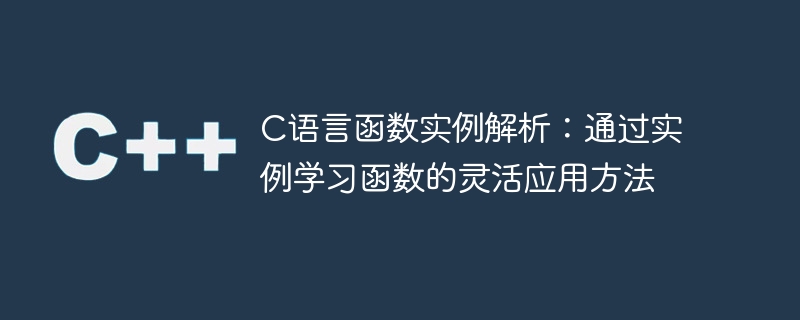

C language function example analysis: learn the flexible application method of functions through examples, you need specific code examples
In C language, functions are the basic modules of programs, you can Complete specific tasks. By properly designing and organizing functions, we can achieve code reuse and logic clarity. This article will introduce the flexible application methods of C language functions through several specific code examples to help readers better understand and use functions.
First, let’s look at a function used to find the maximum and minimum values in a set of sequences. The code is as follows:
#include <stdio.h>
void findMaxMin(int arr[], int size, int *max, int *min) {
*max = arr[0];
*min = arr[0];
for (int i = 1; i < size; i++) {
if (arr[i] > *max) {
*max = arr[i];
}
if (arr[i] < *min) {
*min = arr[i];
}
}
}
int main() {
int arr[] = {10, 5, 8, 3, 12};
int size = sizeof(arr) / sizeof(arr[0]);
int max, min;
findMaxMin(arr, size, &max, &min);
printf("最大值为:%d
", max);
printf("最小值为:%d
", min);
return 0;
}In the above code, the findMaxMin function receives an integer array, its size and two pointers pointing to the maximum and minimum values respectively. By traversing the array, the values pointed to by the maximum and minimum pointers are continuously updated, and finally the maximum and minimum values are obtained. Call the findMaxMin function in the main function and pass it the pointers of the maximum and minimum values. The running result is:
最大值为:12 最小值为:3
Next, let’s look at a function used to calculate the Fibonacci sequence. The code is as follows:
#include <stdio.h>
int fibonacci(int n) {
if (n <= 1) {
return n;
}
return fibonacci(n - 1) + fibonacci(n - 2);
}
int main() {
int n = 10;
printf("斐波那契数列的前%d个数为:", n);
for (int i = 0; i < n; i++) {
printf("%d ", fibonacci(i));
}
return 0;
}In the above code, the fibonacci function uses recursion to calculate the nth number of the Fibonacci sequence. When n is less than or equal to 1, the function directly returns n, otherwise the fibonacci function is called recursively and their sum is returned. The main function calls the fibonacci function through a loop to output the first n numbers of the Fibonacci sequence. The running result is:
斐波那契数列的前10个数为:0 1 1 2 3 5 8 13 21 34
Finally, let’s look at a function for reversing a string. The code is as follows:
#include <stdio.h>
#include <string.h>
void reverseString(char *s) {
int left = 0;
int right = strlen(s) - 1;
while (left < right) {
char temp = s[left];
s[left] = s[right];
s[right] = temp;
left++;
right--;
}
}
int main() {
char str[] = "Hello, World!";
printf("反转前的字符串:%s
", str);
reverseString(str);
printf("反转后的字符串:%s
", str);
return 0;
}In the above code, the reverseString function receives a pointer to a character array and reverses the string by exchanging the positions of characters. Define a character array in the main function and call the reverseString function to reverse it. The running result is:
反转前的字符串:Hello, World! 反转后的字符串:!dlroW ,olleH
Through the above three specific code examples, we can see the flexible application of functions in C language. Whether it's finding the maximum and minimum values, calculating the Fibonacci sequence, or reversing a string, functions can help us achieve code reuse and logic clarity. I hope that through the analysis of this article, readers can better understand and use the flexible application methods of C language functions.
The above is the detailed content of Learn to apply functions flexibly: explore C language functions through examples. For more information, please follow other related articles on the PHP Chinese website!
 direct3d function is not available
direct3d function is not available
 My computer can't open it by double-clicking it.
My computer can't open it by double-clicking it.
 Introduction to software development tools
Introduction to software development tools
 Usage of Type keyword in Go
Usage of Type keyword in Go
 Introduction to the main work content of the backend
Introduction to the main work content of the backend
 Tutorial on buying and selling Bitcoin on Huobi.com
Tutorial on buying and selling Bitcoin on Huobi.com
 How to use countif function
How to use countif function
 What currency is PROM?
What currency is PROM?




